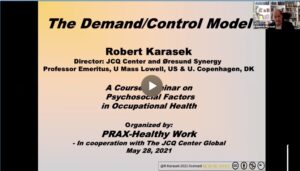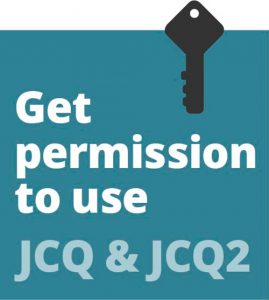Resources & FAQ
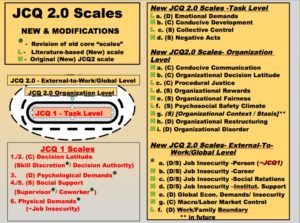
Read more about Karasek Healthy Work
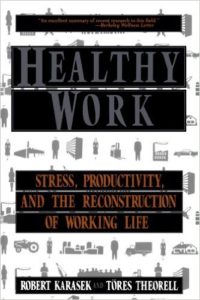
FAQ
Q. I have heard that you dropped the 9-item psychological demands scale and instead now recommend the researchers to use 5-item psychological demand. Is this true? In addition, can you let me know the reasons?
A: Yes, it is true. We recommended in March 2002 at the ICOH 3rd CVD Conference that only the 5-item version of psychological demands be used. The 9-item version was no longer recommended by the JCQ Center. The reasons were two: 1) 9-items did not loaded on a factor (psychological demands) in factor analysis with a Canadian study and an European study, and 2) inversed associations of the 9-item psychological demands with psychological strain outcomes were reported in a Danish study and the JACE study, as opposed to the first 5-item psychological demands.
Q. Can I add additional supervisor support item and additional coworker support item of the JCQ into the supervisor support and coworker support scale scoring process respectively? What do you think about this idea?
A: In fact, conceptually questions can be included into the supervisor and coworker support scales.
Validity and Reliability
Q. Where can I get the validity and reliability information on the JCQ scales? Which articles do you recommend for me to read?
A: We recommend you to read the following articles: 1. Karasek R and Theorell T. (1990). Healthy Work: Stress, Productivity, and the Reconstruction of Working Life (Appendix I). New York: Basic Books. 2. Karasek R, Schwarz J, Theorell T. Final NIOSH Report (1982). 3. Karasek R, Brisson C, Kawakami N, Houtman I, Bongers P, Amick B. (1998) The Job Content Questionnaire (JCQ): An instrument for internationally comparative assessment of psychosocial job characteristics. J Occup Health Psychol, 3:322-355. 4. Karasek R, Choi B, Ostergren P, Ferrario M for the JACE study group. (2003) Comparative international reliability and validity study of JACE-Job Content Questionnaire (JCQ): European worker's psychosocial job characteristics (submitted).
Q. you have and are you willing to provide a list of the articles that have examined your job control/job demand theory of job strain. I have found and used many supportive articles, but I am now looking for a comprehensive list and thought you might have one.
A: Please refer to the following studies (not exhaustive, we keep updating the list of studies).
Mental Health
- Karasek RA. Job demands, job decision latitude, and mental strain: Implications for job redesign. Administrative Science Quarterly 1979; 24: 285-308.
- Der Doef M and Maes S. The job demand-control(-support) model and psychological well-being: a review of 20 years of empirical research. Work & Stress 1999;13:87-114.
- Paterniti S, Niedhammer I, Lang T and Consoli S. Psychosocial factors at work, personality traits and depressive symptoms. British Journal of Psychiatry 2002;181:111-117
- Stansfeld SA, Fuhrer R, Shipley M, Marmot MG. Work characteristics predict psychiatric disorder: prospective results from the Whitehall II study. Occupational and Environmental Medicine 1999; 56: 302-307
Cardiovascular Disease
- Belkic K, Landsbergis P, Schnall P, Baker D, Theorell T, Siegrist J, Peter R, and Karasek RA. Psychosocial factors: review of the empirical data among men. In Occupational medicine: the workplace and cardiovascular disease (state of the art reviews), Schnall PL, Belkic K, Landsbergis P, Baker D(eds). Hanley & Belfus, Inc. 2000; 175-177.
- Bosma H, Marmot M, Hemingway H, Nicholson AC, Brunner E, Stansfeld SA. Low job control and risk fo coronary heart disease in Whitehall II (prospective cohort) study. BMJ 1997;314:558-65.
- Bosma H, Stansfeld SA, Marmot MG. Job control, personal characteristics and heart disease. J Occup Health Psychol 1998; 3: 402-409.
- Hallqvist J, Diderichsen F, Theorell T, Reuterwall C, Ahlbom A and SHEEP study group. Is the effect of job strain on myocardial infarction risk due to interaction between high psychological demands and low decision latitude? Results from Stockholm Heart Epidemiology Program(SHEEP). Soc. Sci. Med. 1998; 46: 1405-1415.
- Johnson JV, Hall EM. Job strainm workplace social support, and cardiovascular disease: a cross-sectional study of a random sample of the Swedish working population. American Journal of Public Health 1988;78:1336-1342
- Johnson JV, Hall EM, Theorell T. Combined effects of job strain and social isolation on cardiovascular disease morbidity and mortality in a random sample of the Swedish male working population. Scand J Work Environ Health 1989;15:271-279
- Johnson JV, Stewart W, Hall EM, Fredlund P, Theorell T. Long-term psychosocial work environment and cardiovascular mortality among Swedish men. American Journal of Public Health 1996;86:324-331
- Karasek RA, Baker D, Marxer F, Ahlbom A and Theorell T. Jon decision latitude, job demands, and cardiovascular disease: a prospective study of Swedish men. American Journal of Public Health 1981; 71: 94-705
- Karasek RA, Theorell T. Healthy Work: Stress, productivity, and the Reconstruction of working life. New York: Basic Books 1990.
- Kristensen TS. Job Stress and Cardiovascular Disease: A theoretical Critical Review, J Occup Health Psychol 1996; 1: 246-260.
- Kuper H, Marmot M, and Hemingway H.. Systemic review of prospective cohort studies of psychosocial factors in the etiology and prognosis of coronary heart disease. Seminars in vascular medicine 2002; 2:267-314
- Landsbergis PA, Schurman SJ, Israel BA, Schnall PL, Hugentobler MK, Cahill J, and Baker D. Job stress and Heart disease: evidence and strategies for prevention. New solutions 1993; Summer:42-58
- Landsbergis PA, Schnall PL, Warren K, Pickering T, Schwarz JE. Association between ambulatory blood pressure and alternative formulations of job strain. Scand J Work Environ Health 1994; 20: 314-28
- Schnall P, Pieper C, Schwartz JE, Karasek RA, Schlussel Y, Devereux RB, Ganau A, Alderman M, Warren K, Pickering TG. The relationship between 'job strain,' workplace diastolic blood pressure, and left ventricular mass index. Results of a case-control study. JAMA 1990;263:1929-1935.
- Schnall P and Landsbergis. Job strain and cardiovascular disease. Annu. Rev. Public Health 1994;15:381-411
- Schnall P, Landsbergis P, Belkic K, Warren K, Schwarz J, Pickering T. Findings in the Cornell University ambulatory blood pressure worksite study: a review. Homeostasis, 1998, 38; 195-215.
- Theorell T, Karasek RA. Current issues relating to psychosocial job strain and cardiovascular disease research. Journal of Occupational Health Psychology 1996;1:9-26
- Theorell T, Tsutsumi A, Hallquist J, Reuterwall C, Hogstedt C, Fredlund P, Emlund N, Johnson JV and the Sheep study group. Decision latitude, job strain, and myocardial infarction: a study of working men in Stockholm. Americal Journal of Public Health 1998; 88:382-388
Musculoskeletal Disorders
- Bongers PM, Winter CR, Kompier M, Hilderbrandt V. Psychosocial factors at work and musculoskeletal disease. Scand J Work Environ Health 1993;19:297-312
- Bongers PM, Kremer AM, Laak JT. Are psychosocial factors, risk factors for symptoms and signs of the shoulder, elbow, or hand/wrist?: A review of the epidemiological literature. Am J Ind Medicine 2002; 41: 315-342
- Kivimaki M, Vahtera J, Ferrie JE, Heminhway H, Pentti J. Organizational downsizing and musculoskeletal problems in employees: a prospective study. Occup Environ Med 2001;58:811-817
- MacDonald LA, Karasek RA, Punnett L, and Scharf T. Covariation between workplace physical and psychosocial stressors: evidence and implications for occupational health research and prevention. Ergonomics 2001;44:696-718
Critiques on the Demand-Control Model
- Kristensen TS. The demand-control-support model: methodological challenges for future research. Stress Medicine 1995;11:17-26
Muntaner C and O'Campo P. A critical appraisal of the demand/control model of the psychosocial work environment: epistemological, social, behavioral and class considerations. Soc. Sci. Med 1993; 36:1509-1517.
Definition of High Job Strain
Q. How can I define the "high job strain" group according to the Karasek's Demand and Control Model?
A: Please refer to the study: Landsbergis PA, Schnall PL, Warren K, Pickering TG, Schwarz JE. (1994). Association between ambulatory blood pressure and alternative formulations of job strain. Scand J Work Environ Health, 20, 314-28. In the paper, you will see four different methods (two "quadrant definition" and two "quotients definition" of high strain groups).
The first quadrant definition is "below the population mean on decision latitude and above the mean on psychlogical demands". The second quadrant definition is based on the "national-level" mean values on decision latitude and psychological demands. The first quotient definition is based on a continuous score of job strain by computing "psyhcological demands divided by decision latitude". This quotient term is nonlinear and tends to give more weight to decision latitude (denominator) than psychological demands. The second quotient definition is based on the equal weight of both decision latitude and psychological demands. For both quotient definitions it is absolutely essential that the resulting values be truncated to eliminate the extreme values that develop when dividing by very low/high values of decision latitude - which can easily distort regression findings.
Karasek, Choi, et al (Comparative scale scores between the JCQ and JCQ-like questionnaires in the JACE study (manuscript), 2004) observe that the classification error in identification of the job strain population is reduced by exclusion of that segment of the strain population that is closest to the population mean (the consistency among different instruments all measuring strain improves). A practical method for accomplishing this goal begins by dividing both the psychological demands and the decision latitude scales into quartiles. This yields a bivariate distribution of 16 cells. This distribution can generate a seven-level scale by stepping incrementally along the diagonal from low to high strain (see Figure 2). For dichotomization to identify a "job strain" population, it is recommended that the three corner cells (levels 6 and 7) be defined as "job strain", and the remainder as non strain.
Also, a multiple level active-passive diagonal can be defined in an analogous manner, but following orthogonal diagonals to the low-high strain diagonals. This would yield another seven-level scale which we would then recommend cutting at (6, 7) vs. (1 to 5) to generate a "passive job sub-population." A more elaborate version of the this technique can be used to modify the often-used four-part demand control model diagram utilizing four quadrants of: strain job, low strain job, active job and passive job." A new "mid-population" category can be generated by consolidating the closest-to-the-bivariate-mean quartile-by-quartile cells from each of the four quadrants. This yields a new five part version of the diagram (see Figure 2B), which may be relevant to some analytic purposes.
Publication and Publishing - Reproductions in any context
- The full Karasek Questionnaires, JCQ, JCQ2 or any scales or parts of questions from the questionnaires / JCQ Question texts (full question) are NOT allowed to be distributed in any context or in any location.
- DISTRIBUTING AN ENTIRE Karasek Questionnaire, JCQ, JCQ2 or any scales or part of questions from the questionnaire/ JCQ texts are NOT allowed.
- Karasek Questionnaire, JCQ, JCQ2 or any scales or part of questions from the questionnaire/ JCQ texts is NOT to appear in any regular public publication, except as the "keywords".
- You are allowed to use the keywords (instead of the JCQ Question) in academic research publications and journal publications after you have paid the license - the allowed keywords are noted in the material you will received after you have paid the price mention here for use of JCQ in your project.
- All reproductions in any medium need special permission and need to be purchased from the JCQ Center Global ApS.
- You are not allowed to send JCQ Center Global instruments in the text of an email or as a PDF file to survey participants.
The Copyright Statement
- All reproductions need to include the word “©Copyright R. Karasek JCQ Center Global ApS. All rights reserved. www.jcqcenter.com”. This statement should be either on all pages or immediately following a partial use of the instrument (e.g., a table where permission has been received).
- Purchase the licenses to administer your survey. Your licenses will include a letter of permission specifying the sample item and keywords you may include in your Dissertation or in Published Work and the copyright statement to use. The entire instrument may not be reproduced in any context. If you find a complete instrument published in any source, please let us know.
Scale and Scoring
Q.How many questions will you recommend if I only want to do a pilot study for my MSc dissertation?
A:It depends on your research questions and your research objectives and if you use JCQ or JCQ2. However, we often recommend the 35 questions which include the following questions: items for skill discretion, items for decision latitude, items for macro-level decision latitude, items for psychological demands, items for physical demands, items for job insecurity, items for supervisor support, and items for coworker support respectively (for detail, read the JCQ user's manual).
Q. Except for the recommended questions, what other scales does the JCQ have?
A:The JCQ has many more questions which you might be interested in: scales measuring psychological strain and job dissatisfaction, scales for physical hazard and exposure, new scales for work social identity, customer contact problem, and global competitive effects.
Q. can I compute the scale scores for the questionnaire scales?
A:you need the Users Manual or our online service can do the compute for you.
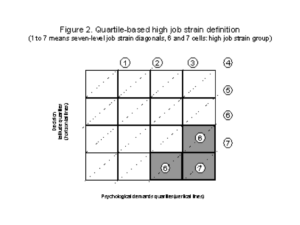
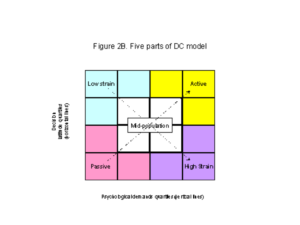
Translation
Q.So far, how many language versions of the JCQ does the JCQ Center have?
A: So far, the JCQ was translated into 29+ countries' languages See Translations.
Q. I would like to translate the JCQ into my country's language. Please let me know the procedure of the translation.
A: Translations of JCQ questions, Karasek Questionnaires, JCQ, JCQ2 or any scales or parts of question from the questionnaires into the languages of the site countries, and back translation of the questions into English are to be:
1. Approved by R. Karasek by a signed translation agreement with JCQ Center Global
2. Provided to the JCQ Center Global ApS (a copy of the translation needs to be sent).
These may be distributed by the JCQ Center in the future to other users under the same conditions as the English version. All rights to the translation belong to the instrument author and copyright holder R. Karasek, JCQ Center Global ApS.
Information and policies for using Karasek questionnaires, JCQ/JCQ2 or scales or questions from the questionnaire in your project:
License and cost related to use of the instrument
-There are usage charges for all Karasek questionnaires, JCQ/JCQ2 or scales or questions from the questionnaire. The JCQ license and our online platform service maintain an active community network, insure that the JCQ is appropriately used and validated, and maintain the needed JCQ quality control in its many usage locations.
-The permission/license to use the JCQ/JCQ2/Karasek Questionnaires is a project-specific license for an exact project and for a specific sample size and the permission for use allow you to conduct a survey and use the JCQ as an on-paper response questionnaire, distributed one time to respondents, and then collected and scored by the User (the license holder).
-The permission is only valid when the payment is paid to JCQ Center Global ApS and the contract is signed.
-If you intend to use the JCQ for a new project than you have now informed us about and have received permission for, then you need to contact JCQ Center Global ApS again for special new permission and payment.
-You will receive Karasek questionnaires, JCQ/JCQ2 or scales or questions from the questionnaire as a personally coded PDF materials.
Copyright and Publishing - Reproductions in any context
-The full Karasek Questionnaires, JCQ, JCQ2 or any scales or parts of questions from the questionnaires / JCQ Question texts (full question) are NOT allowed to be distributed in any context or in any location.
-DISTRIBUTING AN ENTIRE Karasek Questionnaire, JCQ, JCQ2 or any scales or part of questions from the questionnaire/ JCQ texts are NOT allowed.
-Karasek Questionnaire, JCQ, JCQ2 or any scales or part of questions from the questionnaire/ JCQ texts is NOT to appear in any regular public publication, except as the "keywords".
-You are allowed to use the keywords (instead of the JCQ Question) in academic research publications and journal publications after you have paid the license - the allowed keywords are noted in the material you will received after you have paid the price mention here for use of JCQ in your project.
-All reproductions in any medium need special permission and need to be purchased from the JCQ Center Global ApS.
-You are not allowed to send JCQ Center Global instruments in the text of an email or as a PDF file to survey participants.
Data Copy Requirements
-The user agrees – upon request by the JCQ Center Global - to send a copy of JCQ data, demographic data (and if used the JCQ Center recommended psychological strain scale data).
Translations of JCQ questions, Karasek Questionnaires, JCQ, JCQ2 or any scales or parts of question from the questionnaires into the languages of the site countries, and back translation of the questions into English are to be:
- Approved by R. Karasek by a signed translation agreement with JCQ Center Global
- Provided to the JCQ Center Global ApS (a copy of the translation needs to be sent).
These may be distributed by the JCQ Center in the future to other users under the same conditions as the English version. All rights to the translation belong to the instrument author and copyright holder R. Karasek, JCQ Center Global ApS.
Permission to put Sample Items into a Dissertation or in Published Work
-Permission to put one specific sample items of the instrument into a dissertation or thesis appendix is provided when license to reproduce is purchased. When you have paid the license it provides permission for one specific sample items to show the characteristics of the instrument (see the allowed example on https://www.jcqcenter.com/questionnaires-jcq-jcq2/#karasek. JCQ Center Global will only provide permission for that specific sample items. The goal is to provide an example of content, not to provide a usable scale.
-However, when license to reproduce is purchased you are allowed to use keywords - instead of the JCQ Question – for example in research publications and journal publications. Keywords need to communicate the core meaning of the item loading into the factor but the entire item does not need to be reproduced. JCQ Center Global provides keywords for each item that captures the core meaning. Thus, the goal is realized without violating the copyright.
The Copyright Statement
-All reproductions need to include the word “©Copyright R. Karasek JCQ Center Global ApS. All rights reserved. www.jcqcenter.com”. This statement should be either on all pages or immediately following a partial use of the instrument (e.g., a table where permission has been received).
-Purchase the licenses to administer your survey. Your licenses will include a letter of permission specifying the sample item and keywords you may include in your Dissertation or in Published Work and the copyright statement to use.
-The entire instrument may not be reproduced in any context. If you find a complete instrument published in any source, please let us know.
Alteration of Items and Instruments / Administering Only Part of Karasek Questionnaires, JCQ, JCQ2
-If the instrument is altered it may affect the validity and/or reliability of the instrument because the meaning of the items and/or the directions changes.
-If only part of an instrument is administered, the context changes and the validity properties of the instrument may not still be represented. A warning to this effect should be made in the article.
Karasek Questionnaires, JCQ, JCQ2 or any scales or parts of the questions from the questionnaire vs the User’s Guide
-There is a difference between the User’s Guide-manual and the instrument itself. If you are referring to the User’s Guide-manual, look on the title page of the manual for the title and copyright date, if you are referring to the instrument, look on the first page of the instrument.
Include an instrument in Thesis or Dissertation or for research proposal
-If you need a copy of the instrument for your research proposal, we can offer you to purchase the User guide, which includes one sample copy of the instrument and the keywords of scales for review.
Using our Instruments Online
-Karasek Questionnaires, JCQ, JCQ2 or any scales or parts of questions from the questionnaires may NOT - without special permission - be put on a remote website.
-Karasek Questionnaires, JCQ, JCQ2 or any scales or parts of questions from the questionnaire / JCQ Question texts (full question) may not be retyped and reformatted for online administration.
-If you wish to use Karasek Questionnaires, JCQ, JCQ2 or any scales or parts of the questions from the questionnaire, on a remote website (online service) you need to have asked for and received special permission (field G on the Usage Request Form - special conditions and payment). The policy on the JCQ Center Globals information should be followed and such use needs to be cleared with JCQ Center Global with special payment.
This site is currently being updated....
